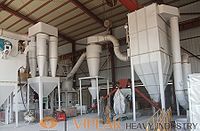Difference between revisions of "Centrifugal Grinding Mills"
(Created page with "Category:Particle Size Reduction{{Knoppen}} <noinclude><!------------------------------------------------ * READ THIS FIRST * Only edit this page if you can improve the c...") |
PurplePen19 (talk | contribs) |
||
| Line 5: | Line 5: | ||
* Please do not edit the sponsored link on the top right corner. . | * Please do not edit the sponsored link on the top right corner. . | ||
* Please start editing this page after the /noinclude | * Please start editing this page after the /noinclude | ||
* -------------------------------------------------></noinclude> | * -------------------------------------------------></noinclude> | ||
This | [[File:Centrifugal Grinding Mills_1.jpg|thumb|200px|right|Centrifugal Grinding Mills]] | ||
'''Centrifugal Grinding Mills''' are [[Mills]] that are used for the rapid size reduction of soft to medium-hard and fibrous materials. | |||
==Features== | |||
*Powerdrive with optimally matched frequency converter and 3-phase motor | |||
*comfortable parameter setting via display and ergonomic 1-button operation | |||
*wide range of accessories including various collection and feeding systems, rotors and sieves | |||
*gentle and very rapid size reduction by pre- and fine grinding in one run | |||
*wide speed range | |||
*easily exchangeable grinding and sieve inserts | |||
*defined final fineness due to ring sieves sieves with aperture sizes from 0.08 - 10 mm | |||
*comfortable safety housing with automatic cover closure | |||
*motor compartment and electronics protected against dust and material penetration | |||
==Work Prinicples== | |||
Size reduction takes place by impact and shearing effects between the rotor and the fixed ring sieve. The feed material passes through the hopper (with splash-back protection) onto the rotor. Centrifugal acceleration throws it outward with great energy and it is precrushed on impact with the wedge-shaped rotor teeth moving at a high speed. It is then finely ground between the rotor and the ring sieve. | |||
This 2-step grinding ensures particularly gentle but fast processing. The feed material only remains in the grinding chamber for a very short time, which means that the characteristic features of the sample to be determined are not altered. The ground sample is collected in the collecting cassette surrounding the grinding chamber or in the downstream cyclone or paper filter bag. | |||
==Processes== | |||
===Dry process=== | |||
The material that enters the feeding silo will fall down onto the cone like the waterfall with 360 degree. The material will be grinded into powder by several rollers in turn, and then be discharged through the Vibrating Screen. | |||
===Wet process=== | |||
The process resembles the dry production; The difference lies in adding water and the dehydration after grinding. This process can be designed according the user's demand. | |||
==Video== | |||
<youtube>Lgmalt0uAZg</youtube> | |||
Latest revision as of 02:49, 12 October 2012
Centrifugal Grinding Mills are Mills that are used for the rapid size reduction of soft to medium-hard and fibrous materials.
Features
- Powerdrive with optimally matched frequency converter and 3-phase motor
- comfortable parameter setting via display and ergonomic 1-button operation
- wide range of accessories including various collection and feeding systems, rotors and sieves
- gentle and very rapid size reduction by pre- and fine grinding in one run
- wide speed range
- easily exchangeable grinding and sieve inserts
- defined final fineness due to ring sieves sieves with aperture sizes from 0.08 - 10 mm
- comfortable safety housing with automatic cover closure
- motor compartment and electronics protected against dust and material penetration
Work Prinicples
Size reduction takes place by impact and shearing effects between the rotor and the fixed ring sieve. The feed material passes through the hopper (with splash-back protection) onto the rotor. Centrifugal acceleration throws it outward with great energy and it is precrushed on impact with the wedge-shaped rotor teeth moving at a high speed. It is then finely ground between the rotor and the ring sieve.
This 2-step grinding ensures particularly gentle but fast processing. The feed material only remains in the grinding chamber for a very short time, which means that the characteristic features of the sample to be determined are not altered. The ground sample is collected in the collecting cassette surrounding the grinding chamber or in the downstream cyclone or paper filter bag.
Processes
Dry process
The material that enters the feeding silo will fall down onto the cone like the waterfall with 360 degree. The material will be grinded into powder by several rollers in turn, and then be discharged through the Vibrating Screen.
Wet process
The process resembles the dry production; The difference lies in adding water and the dehydration after grinding. This process can be designed according the user's demand.
Video
